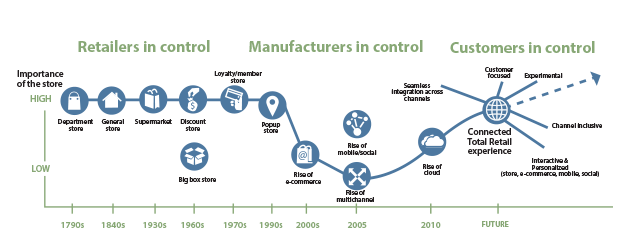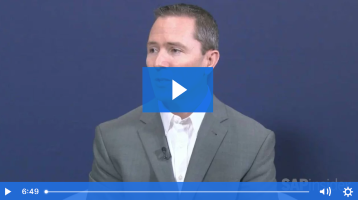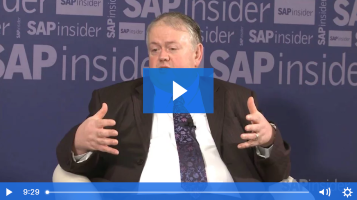Total Retail: Reshaping Your Operating Model to Respond to the Needs of Connected Consumers
The retail industry is going through unprecedented transformation, and a retailer’s success will depend on its ability to embrace this transformation to meet diverse consumer needs. Consumers increasingly expect a seamless, connected experience across channels (including web, mobile, social, and in-store) as part of the buying cycle. But though many organizations have evolved their approach to retail to address the changing needs of consumers, this evolution has had relatively little impact on the business model. Beneath the customer touchpoints, the level of integration across channels is limited and often superficial as retailers get by with inefficient workarounds and fragmented data, which in many cases, adds cost to the existing operating model.
SAP customers are often perpetrators of such inefficiencies as they, for a variety of reasons, have failed to take advantage of the end-to-end process and data integration that the SAP solutions have to offer. But in a world of increasing consumer expectations, business-to-consumer (B2C) and business-to-business (B2B) organizations must integrate data and insights to deliver a seamless, one-stop-shop, Total Retail experience regardless of channel, or they will put their sales, customer engagement, trust, and brand reputation at risk. The need for retail transformation is being driven by four critical forces:
- Customers want personalized offerings and the ability to interact 24/7. Due to the multitude of options available to the modern shopper, customers are now more fickle than ever. If retailers want to keep their customer base, they need to gather and analyze data in real time to understand the needs, preferences, and attitudes of diverse consumers, as well as personalize offers on a one-on-one basis.
- Deeper insights are required for retailers to drive innovation as well as product and brand differentiation. With infinite consumer choices across channels, retailers must develop new, innovative business models to introduce new products and link them to experiences that excite their target market.
- Customer loyalty relates to the brand. Customers demand consistent interactions across channels with their preferred brands. Smartphone adoption has expanded their buying journey across many touch points, and they expect 24/7 availability along with a seamless experience across each channel.
- The customer experience is paramount. Cross-channel shopping has increased service expectations, with precise delivery commitments being the new norm. Customers expect customized offerings based on totally protected personal preferences and information.
The challenge for retailers is to adapt their business operating model to respond to these forces. Delivering a consistent and connected Total Retail experience requires a business transformation into a truly customer-centric retail operating model with seamless integration across channels, underpinned by integrated technology and data models. Competitive advantage in the 21st century is true customer centricity and the capacity for continuous innovation, executed fast and deployed nimbly. Examples include new innovative store layouts, merging of virtual and physical experience, customer engagement across channels, and new approaches to service that deliver a dynamic and personalized experience.

To create a truly connected Total Retail experience, the retail industry needs to evaluate how to best leverage the SAP solutions to unlock competitive advantage, including exploiting the SAP S/4HANA real-time capability for more sophisticated analytics and insights across channels to create a 360-degree view of customers and how their needs can better be served. It doesn’t matter whether they are online or in-store, using mobile devices to integrate online and offline into a seamless, dynamic experience, or exploiting the integrated data model, analytics capabilities, and supply chain integration SAP S/4HANA enables. This is not just about the front end but the whole value chain.
Total Retail: Tomorrow’s Operating Model
The ability to respond to the challenges and demands of increasingly connected consumers requires a fully integrated, digitized, and connected value chain enabled by a simplified, customer-centric business model and organization, one that uses customer data and sophisticated analytics to drive dynamic consumer and market insights. Key tenets of an optimized value chain include:
- Integrating physical and digital store operations under a single management team with shared incentives and key performance indicators (KPIs) that are agnostic of channel
- Creating a flexible data infrastructure to build a single view of customers across channels and interactions in order to deliver real-time insights and personalized experiences
- Building a responsive supply chain that senses and responds to demand across channels, using sophisticated analytics to deliver a personalized experience
- Creating the “Digital Boardroom” to deliver real-time financial and sales performance metrics that enable views of profitability by category, channel, product, and consumer segments to enable proactive decision making and focus on the most profitable products and channels
Companies have previously focused on integrating the back office, but there is a need to integrate the digital front office and supply chain to create responsive and optimized operations that meet consumer needs. For businesses relying on SAP solutions, this means looking at exploiting the SAP S/4HANA capabilities and the SAP Hybris suite for real-time reporting to improve demand forecasting, adapt pricing, and understand profitability and cost-to-serve by product/channel. By configuring the end-to-end value chain to customer-centric principles, companies can deliver the Total Retail experience and meet consumer demands.
Ultimately, the Total Retail experience stems from a new and improved operating model that embraces innovation and fosters connectivity at every level of the business. Fast forward a few years and Total Retailers will embrace this model by offering a truly connected experience where they:
- Use digital capabilities embedded in all parts of the business to ensure real-time innovation and integrate customer data and insights into the customer experience.
- Create a greatly enhanced customer experience by using technology to personalize interactions, integrating experiences seamlessly across all channels including in-store, online, and mobile, and ensuring store and online employees can best service customer needs.
- Simplify operations with a single owner for all retail channels (store and online) and consistent metrics that drive the organization to interact with customers seamlessly in the channel of their choice.
- Create trust with consumers, whether this means ensuring the integrity of the food supply chain, maintaining product quality and accurate product information, or assuring consumers that sensitive data is safe online.
Total Retailers will also be able to develop better connections within their store networks and among networks of other businesses or retail organizations. Consumer goods companies will look more like connected retailers with the advantage of designing their connected network from scratch. They will have direct relationships with consumers (B2C) through a direct-to-consumer channel as well as with through customer B2B channels to enable them to better understand and engage consumers in the brand, innovation, and product development. Tomorrow’s operating model will need to be enabled by new organizational capabilities and underpinned by the following characteristics and trends:
- Innovation: Tommorow’s operating model must allow business transformation through innovative models that may not exist today. Key trends that will drive innovation are distruptive models, co-creation, and ecosystem collaboration.
- Enhanced customer experience: The operating model must deliver a fully integrated and connected consumer experience, regardless of channel. Key trends that will shape retail around the customer experience include social media engagement, consumer-centricity, and omni-channel experiences.
- Simplicity: To respond to a rapidly changing marketplace, simplicity is the answer. The operating model must be agile and truly customer-centric. Key trends driving simplicity are cross-channel integration, loyalty management, sales and service management, and a dynamic supply chain.
- Trust in the brand: In an environment where brand is key, trust has never been more important. Consumers expect a two-way, rewarding relationship. Key trends shaping retail around building brand trust involve business information and analytics, data security and compliance, and cyber security.
PwC can help retailers develop their operating models for the future and prepare to become Total Retailers. For more information, visit: Total Retail (www.pwc.com/gx/en/industries/retail-consumer/global-total-retail.html); If Stores Had a Voice (https://digital.pwc.com/if-stores-had-a-voice); and World in Beta (www.worldinbeta.com).





